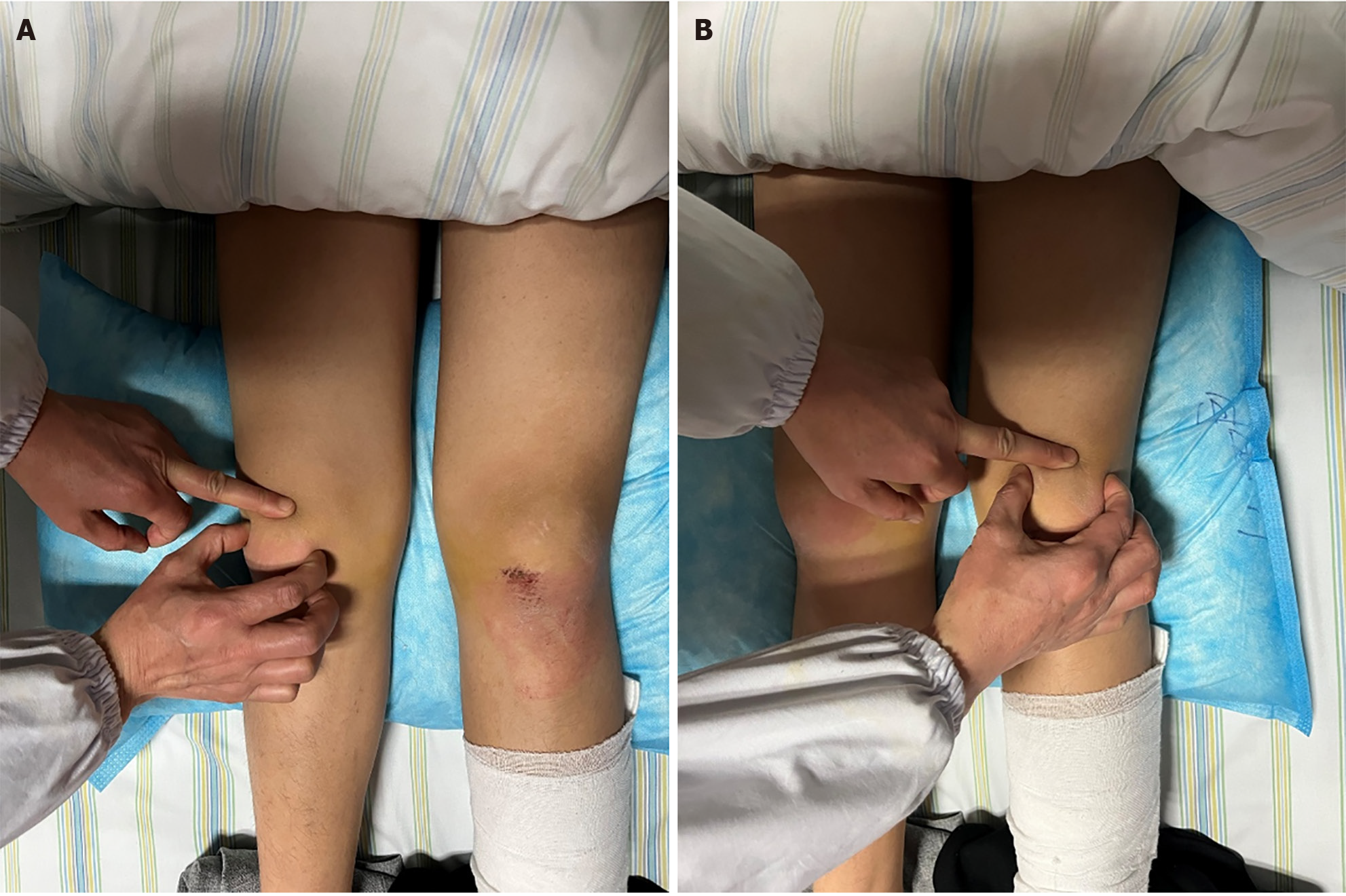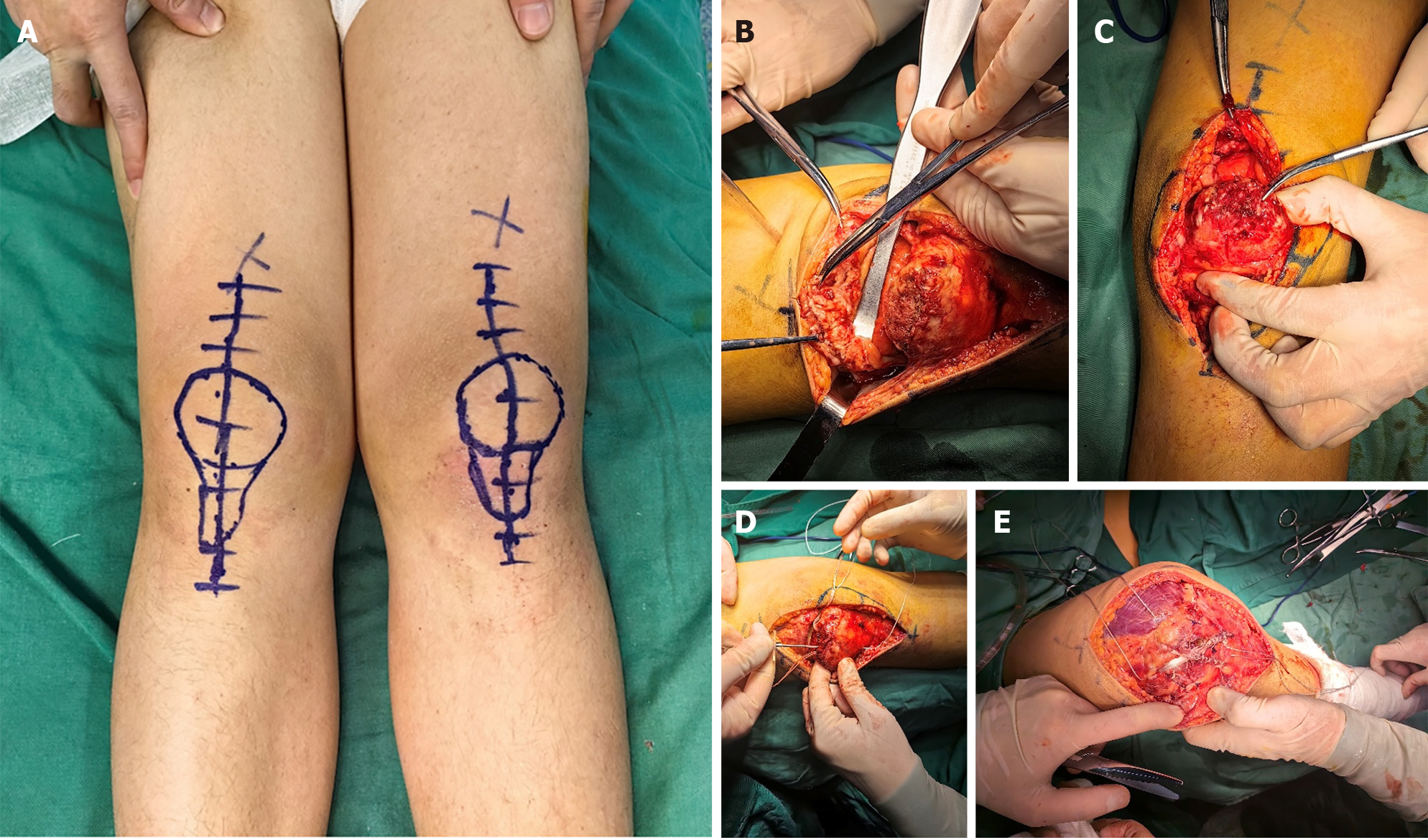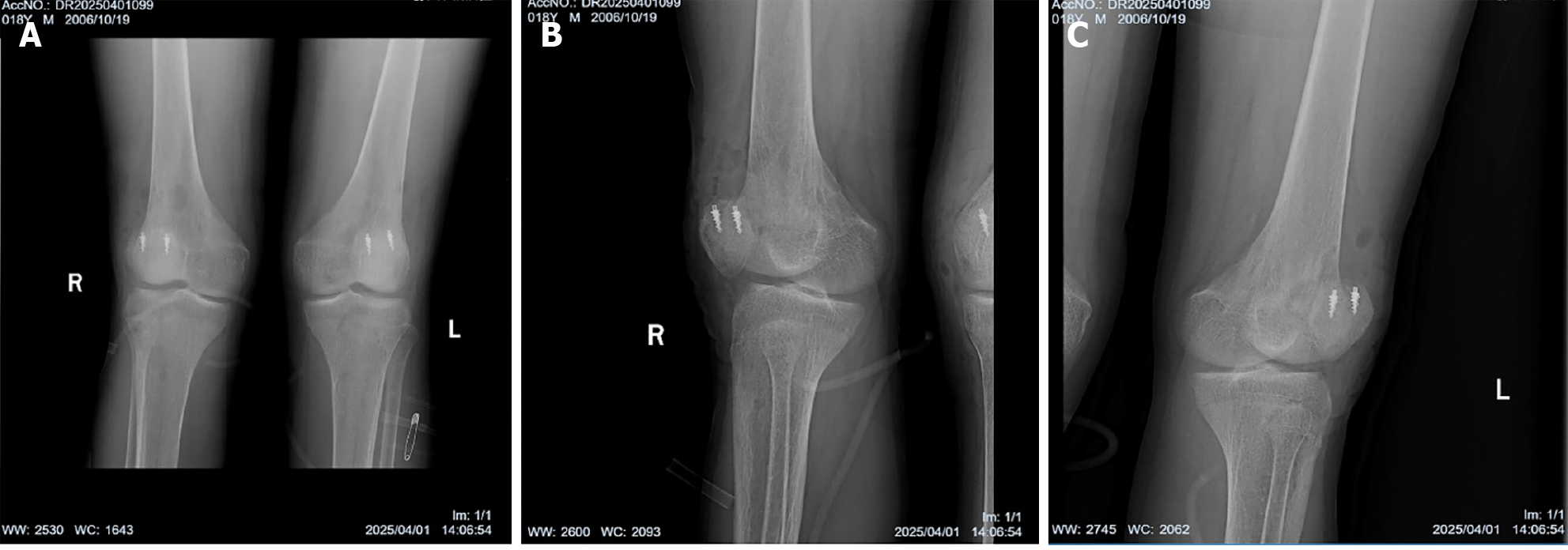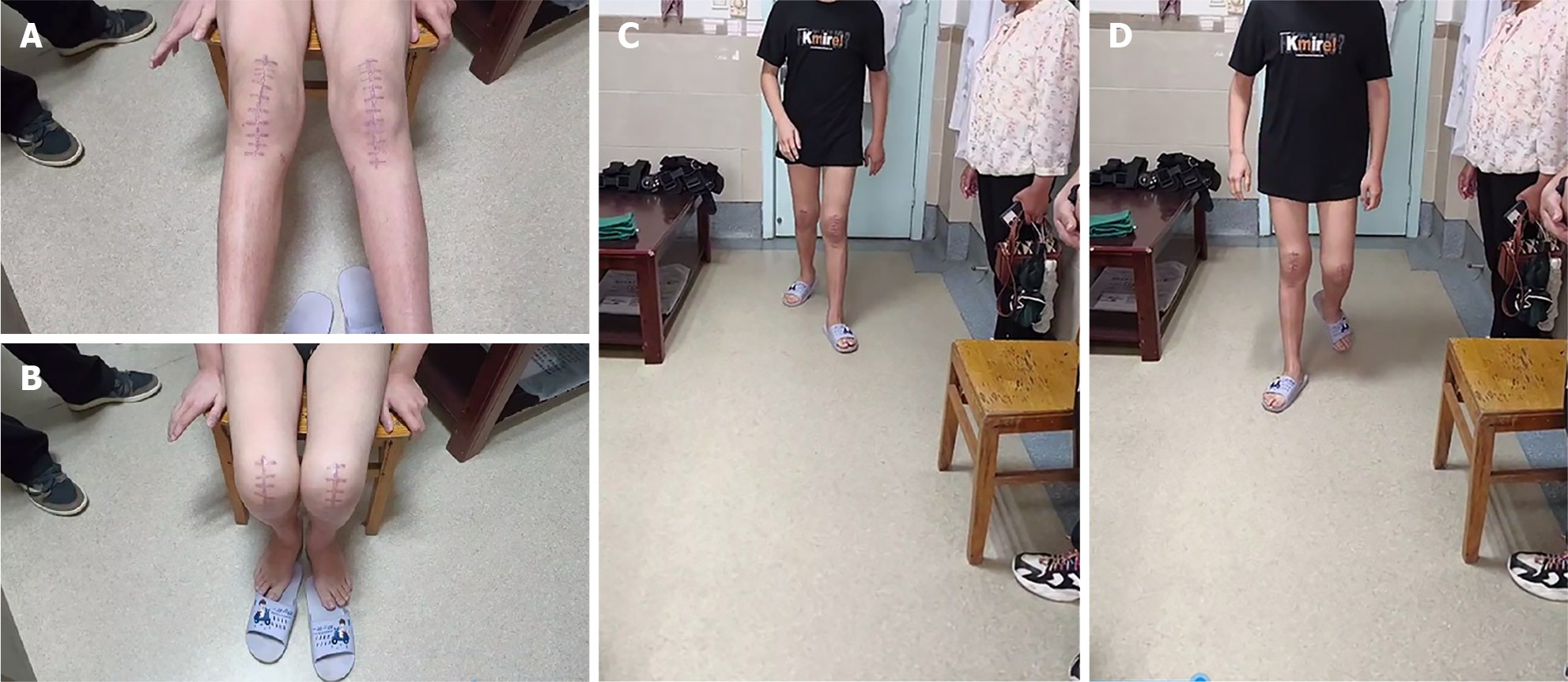Published online Nov 18, 2025. doi: 10.5312/wjo.v16.i11.110173
Revised: July 4, 2025
Accepted: September 25, 2025
Published online: November 18, 2025
Processing time: 168 Days and 2.4 Hours
Sleeve fracture of the patella is an unusual fracture, almost unique to children. The majority of sleeve fractures involve the inferior patellar pole. However, sleeve fractures of the superior pole of the patella are extremely rare in adults.
An 18-year-old male patient fell while running in the morning. The patient had tenderness to palpation at the superior pole of the patella, with a palpable gap over the upper part of the patella in both knees. We applied two 4.5-mm suture anchors with the Krackow stitch to repair the sleeve fracture, augmented by autogenous gracilis through performing the figure-of-eight technique. The patient regained approximately the full range of motion of the knee joint without any quadriceps weakness and a normal gait 6 weeks after surgery.
Sleeve fractures of the superior pole of the patella are extremely rare in adults, especially bilateral sleeve fractures. Suture anchors, augmented by autogenous gracilis, provided secure fixation and achieved excellent results in this rare injury.
Core Tip: Sleeve fractures of the superior pole of the patella were rare in adults. We report an extremely rare case of an 18-year-old man with a bilateral sleeve fracture of the superior pole of the patella that occurred after a sudden fall while running. The patient’s physical examination, imaging examinations, and surgical procedure are presented, along with relevant images. Suture anchors, augmented by autogenous gracilis, provided secure fixation and achieved excellent results in this rare injury.
- Citation: He WP, Ren CM, Luo F, Chen L, Wang WT, Qiu BT, Zhang XC, Chen HT. Bilateral sleeve fracture of the superior pole of the patella in a healthy adult: A case report. World J Orthop 2025; 16(11): 110173
- URL: https://www.wjgnet.com/2218-5836/full/v16/i11/110173.htm
- DOI: https://dx.doi.org/10.5312/wjo.v16.i11.110173
Patellar fractures in children are rare, accounting for 1% of all fractures in children[1-6]. As a particular type of patellar fracture, sleeve fracture of the patella occurs when a “sleeve” of periosteum is torn off from the patella[5,7]. The sleeve fracture was first described by Houghton and Ackroyd in 1979, representing the most common type of patellar fracture in children[7-10]. The majority of sleeve fractures involve the inferior patellar pole[11-14], whereas fracture of the superior pole is a rare occurrence[5,15]. These fractures account for approximately half of all patellar fractures in children, and most cases are under the age of 16[6,10,16]. On reviewing the English literature, only seven cases were found in adults[5,15,17-21]. Compared to the immature pediatric skeleton, the enthesis of the adult patella is more resilient to avulsion injury, which may account for the low incidence in adults[15]. We report an extremely rare case of an 18-year-old man with a bilateral sleeve fracture of the superior pole of the patella that occurred after a sudden fall while running. To our knowledge, this is the first case of bilateral sleeve fracture of the superior pole of the patella in adults. The patient and his family were informed that data concerning the case would be submitted for publication, and they consented.
An 18-year-old Chinese man was admitted to the hospital on March 26, 2025, due to an injury sustained by falling while running in the morning.
The patient fell while running in the morning. The patient felt pain and swelling in both knee joints after both knees joints landed on the ground. The lower legs on both sides could not be raised independently.
There was no history of fracture or surgery.
The patient had no significant past medical, surgical, or family history.
Mild joint effusion was present in both knees. The patient had tenderness to palpation at the superior pole of the patella, with a palpable gap over the upper part of the patella in both knees (Figure 1). He was unable to actively extend his knee in the sitting position and felt severe pain performing this action.
No abnormalities were revealed by the laboratory examinations.
Magnetic resonance imaging (MRI) confirmed bilateral sleeve fracture of the superior pole of the patella (Figure 2).
Based on the history, physical examination, and imaging examinations, the patient was diagnosed with bilateral sleeve fractures of the superior pole of the patella.
The patient underwent open surgery for reconstruction of the knee extension apparatus 4 days after the trauma under general anesthesia through an anterior approach (Figure 3A). At surgery, a sleeve fracture of the superior pole of the patella was further confirmed, but there was no fragment of articular cartilage. There was a thin shell of bone avulsed from the proximal pole of the patella by the quadriceps tendon (Figure 3B and C). The quadriceps tendon with the patellar fracture piece was meticulously repaired and secured to the main patellar body by two 4.5-mm suture anchors with the Krackow stitch (Figure 3D). This repaired tendon was augmented with the autogenous gracilis by performing the figure-of-eight technique (Figure 3E).
Postoperative plain radiography showed that the anterior tilt of the patella had been corrected, and the position of the suture anchors was good (Figure 4). Postoperatively, the knee was immobilized with an adjustable knee joint brace for 4 weeks. Six weeks after the surgery, the patient regained approximately a full range of motion of the knee joint, without any quadriceps weakness on clinical examination (Figure 5A and B). Meanwhile, the patient regained a normal gait (Figure 5C and D).
Sleeve fracture of the patella is an unusual type of fracture, almost unique to children[3,5,22,23]. The predominance of this injury in children may be due to their more flexible ligaments, hyaline cartilage, and joint capsule, resulting in greater joint laxity that protects the patella from trauma[5,22]. Therefore, avulsion fracture of the subchondral bone, or of the cartilage and retinaculum, is found more frequently than tendon rupture[2-4,6]. To our knowledge, only seven articles have reported specific cases of superior pole sleeve fractures of the patella in adults (Table 1). For the first time, we reported an extremely rare case of bilateral sleeve fracture of the superior pole of the patella in adults. We applied two 4.5-mm suture anchors with the Krackow stitch to repair the sleeve fracture, augmented by autogenous gracilis through performing the figure-of-eight technique. Our treatment provided secure fixation and excellent results in this rare injury.
| Ref. | Age | Gender | Mechanism | Treatment | Outcome (after surgery) |
| Xie et al[5], 2017 | 19 | Female | Fall while jumping | Surgery | Full recovery at 6 months |
| Kushwaha et al[15], 2021 | 18 | Male | Fall while trying to jump across a wall | Surgery | Full ROM at 10 weeks |
| Quraishi et al[17], 2021 | 23 | Male | Fall from bike | Surgery | Full ROM at 4 months; return to sports activity at 16 months |
| Ro et al[18], 2014 | 24 | Male | Forceful passive physiotherapy following cast immobilization | Surgery | Full ROM at 6 months; return to sports activity at 26 months |
| Teixeira et al[19], 2013 | 22 | Male | Forceful kick to ball | Conservative | Full ROM and return to normal activity at 3 weeks |
| Hemeleers et al[20], 2018 | 19 | Male | Fall on ground | Conservative | No follow-up |
| Kakazu et al[21], 2003 | 30 | Male | Slip on ground | Surgery | Return to daily activity at 6 months |
Sleeve fractures of the patella usually occur in the inferior pole of the patella, and superior pole involvement is rare. There are different mechanisms underlying these two types of sleeve fractures. It is proposed that inferior pole sleeve fractures are due to rapid quadriceps muscle contraction, as occurs in jumping and skateboarding[15,18]. However, sleeve fracture of the superior pole occurs as a result of rapid quadriceps muscle contraction, with knee flexion that results in more force acting on the superior pole compared to the inferior pole. A plausible explanation for the fracture in the present case is that forced flexion while falling resulted in momentary tensile force at the quadriceps attachment site acting on the superior pole of the bilateral patella, similar to previous cases[15,18,19].
Sleeve fractures of the superior pole of the patella are extremely rare in adults and easy to neglect[15]. A plain radiograph may be misleading, and MRI remains the ideal imaging modality[17]. Based on the chief complaints and physical examination, we highly suspected rupture of the quadriceps tendon, which seemed to be confirmed by MRI. However, during the surgery, we found a thin shell of bone avulsed from the proximal pole of the patella by the quadriceps tendon. The patient was finally diagnosed with a bilateral sleeve fracture of the superior pole of the patella. Previous cases of sleeve fractures of the patella[5,17,19,24] presented the inability to raise the leg, consistent with the clinical manifestations in our case. Thus, sleeve fractures of the patella should be considered when patients have limited mobility.
Treatment options include conservative and operative management, according to the displacement and size of the fragment. In two adult cases, conservative treatment was chosen for the fractures as the displacement was not greater than 2 mm[19,20]. Conservative management is mainly applicable to minimally displaced fractures and may cause retraction of the quadriceps muscle as well as joint stiffness. Furthermore, the avulsed sleeve tissue in our patient had osteogenic tissue due to the periosteal sleeve being attached to the fracture fragment. Missed diagnosis or a delay in treatment may cause new bone formation and permanent disability[15]. Therefore, surgical management for this type of fracture is the preferred treatment. At present, there is no standard treatment for a sleeve fracture of the superior pole of the patella. Strong and secure fixation is crucial for rapid postoperative recovery. The use of the figure-of-eight technique for autologous graft augmentation is reliable for early postoperative rehabilitation, without interfering with the healing of sleeve fractures. Our case regained approximately the full range of motion of the knee joint and a normal gait 6 weeks after the surgery, showing faster recovery than other adult cases undergoing surgery[5,15,17,18,21].
Although the injury mechanism is similar, quadriceps tendon rupture needs to be distinguished from sleeve fractures of the superior pole of the patella. Quadriceps tendon ruptures in the native knee are relatively rare and require a pathologic tendon[25,26]. Most patients who suffer quadriceps ruptures have underlying disease[27], including diabetes, thyroid disease, renal disease, etc. The laboratory examinations were normal in our patient. Furthermore, the site of quadriceps tendon rupture is in the tendon section, while the site of sleeve fractures of the superior pole is the junction of the tendon and bone. There is a particularly high male predominance of sleeve fracture of the superior pole in adults, with six male and one female case being reported[5,15,17-21]. Our case also occurred in a male patient. The reasons for the gender differences in this disease need further clarification.
Sleeve fractures of the superior pole of the patella are extremely rare in adults. For the first time, we present a bilateral sleeve fracture in an 18-year-old man. A palpable gap over the upper part of the patella should be considered in this type of fracture and verified by MRI. Suture anchors, augmented by autogenous gracilis, provided secure fixation and achieved excellent results in this rare injury.
| 1. | Bates DG, Hresko MT, Jaramillo D. Patellar sleeve fracture: demonstration with MR imaging. Radiology. 1994;193:825-827. [RCA] [PubMed] [DOI] [Full Text] [Cited by in Crossref: 120] [Cited by in RCA: 79] [Article Influence: 2.5] [Reference Citation Analysis (0)] |
| 2. | Hunt DM, Somashekar N. A review of sleeve fractures of the patella in children. Knee. 2005;12:3-7. [RCA] [PubMed] [DOI] [Full Text] [Cited by in Crossref: 88] [Cited by in RCA: 60] [Article Influence: 3.0] [Reference Citation Analysis (0)] |
| 3. | Maripuri SN, Mehta H, Mohanty K. Sleeve fracture of the superior pole of the patella with an intra-articular dislocation. A case report. J Bone Joint Surg Am. 2008;90:385-389. [RCA] [PubMed] [DOI] [Full Text] [Cited by in Crossref: 23] [Cited by in RCA: 16] [Article Influence: 0.9] [Reference Citation Analysis (0)] |
| 4. | Ray JM, Hendrix J. Incidence, mechanism of injury, and treatment of fractures of the patella in children. J Trauma. 1992;32:464-467. [RCA] [PubMed] [DOI] [Full Text] [Cited by in Crossref: 72] [Cited by in RCA: 50] [Article Influence: 1.5] [Reference Citation Analysis (0)] |
| 5. | Xie L, Xu H, Zhang L, Xu R, Guo Y. Sleeve fracture of the adult patella: Case report and review of the literature. Medicine (Baltimore). 2017;96:e7096. [RCA] [PubMed] [DOI] [Full Text] [Full Text (PDF)] [Cited by in Crossref: 7] [Cited by in RCA: 6] [Article Influence: 0.8] [Reference Citation Analysis (0)] |
| 6. | Gettys FK, Morgan RJ, Fleischli JE. Superior pole sleeve fracture of the patella: a case report and review of the literature. Am J Sports Med. 2010;38:2331-2336. [RCA] [PubMed] [DOI] [Full Text] [Cited by in Crossref: 26] [Cited by in RCA: 22] [Article Influence: 1.5] [Reference Citation Analysis (0)] |
| 7. | Lindor RA, Homme J. Patellar Fracture with Sleeve Avulsion. N Engl J Med. 2016;375:e49. [RCA] [PubMed] [DOI] [Full Text] [Cited by in Crossref: 3] [Cited by in RCA: 3] [Article Influence: 0.3] [Reference Citation Analysis (0)] |
| 8. | Houghton GR, Ackroyd CE. Sleeve fractures of the patella in children: a report of three cases. J Bone Joint Surg Br. 1979;61-B:165-168. [RCA] [PubMed] [DOI] [Full Text] [Cited by in Crossref: 103] [Cited by in RCA: 78] [Article Influence: 1.7] [Reference Citation Analysis (0)] |
| 9. | Moreira FP, Costa FP, Santos SA, Oliveira PR. Superior pole patellar sleeve fracture after medial patellofemoral ligament reconstruction. BMJ Case Rep. 2021;14:e239364. [RCA] [PubMed] [DOI] [Full Text] [Cited by in Crossref: 1] [Cited by in RCA: 2] [Article Influence: 0.5] [Reference Citation Analysis (0)] |
| 10. | Siddiqui R, Singh A, Cullinan C. Superior Pole Sleeve Fracture of the Patella in an Adolescent: A Case Report. JBJS Case Connect. 2020;10:e20.00007. [RCA] [PubMed] [DOI] [Full Text] [Cited by in Crossref: 1] [Cited by in RCA: 5] [Article Influence: 1.0] [Reference Citation Analysis (0)] |
| 11. | Li T, Xiang M, Lv X, Gan Y, Yu S. Bilateral sleeve fracture of the inferior pole of the patella in children: A case report. Front Surg. 2022;9:970802. [RCA] [PubMed] [DOI] [Full Text] [Full Text (PDF)] [Cited by in RCA: 3] [Reference Citation Analysis (0)] |
| 12. | Pandit DK, Regmi B, Subedi D, Jha D. Management of inferior patellar sleeve fracture by ORIF with ortho cord suture: A case report. Int J Surg Case Rep. 2025;127:110875. [RCA] [PubMed] [DOI] [Full Text] [Cited by in RCA: 1] [Reference Citation Analysis (0)] |
| 13. | Desai VM, DeFrancesco CJ, Yellin JL, Nguyen JC, Williams BA. Patient Characteristics and Postoperative Outcomes of Surgically Treated Inferior Pole Patellar Sleeve Fractures. J Pediatr Orthop. 2024;44:483-488. [RCA] [PubMed] [DOI] [Full Text] [Cited by in RCA: 3] [Reference Citation Analysis (0)] |
| 14. | Usami S, Naraoka T, Sasaki S, Oishi K, Ishibashi Y. Bilateral Sleeve Fracture of the Patella in a Healthy 11-Year-Old Male: A Case Report. Cureus. 2023;15:e50347. [RCA] [PubMed] [DOI] [Full Text] [Cited by in RCA: 1] [Reference Citation Analysis (0)] |
| 15. | Kushwaha SS, Kumar N, Bharti A, Maurya G. Neglected Isolated Sleeve Fracture of the Superior Pole of the Patella in a Healthy Adult - A Case Report and Review of Literature. J Orthop Case Rep. 2021;11:104-107. [RCA] [PubMed] [DOI] [Full Text] [Full Text (PDF)] [Cited by in RCA: 1] [Reference Citation Analysis (0)] |
| 16. | Güler Y, Arslanoğlu F, Korkmaz O, Hakyemez ÖS, Ateş G, Çaçan MA. Missed Sleeve Fracture of the Superior Pole of Patella. Acta Chir Orthop Traumatol Cech. 2020;87:127-128. [PubMed] |
| 17. | Quraishi F, Khan I, Quraishi AG. Case Report on Sleeve Avulsion of Patella in Young Adult. J Orthop Case Rep. 2021;11:94-97. [RCA] [PubMed] [DOI] [Full Text] [Full Text (PDF)] [Cited by in RCA: 1] [Reference Citation Analysis (0)] |
| 18. | Ro KH, Park JH, Kim MJ, Lee DH. Rare sleeve fracture of the superior patella pole in an adult due to forceful passive physiotherapy following cast immobilization. Knee. 2014;21:600-604. [RCA] [PubMed] [DOI] [Full Text] [Cited by in Crossref: 4] [Cited by in RCA: 8] [Article Influence: 0.7] [Reference Citation Analysis (0)] |
| 19. | Teixeira PA, Lecocq S, Moisei A, Chanson A, Louis M, Blum A. Sleeve-like avulsion fracture of the superior pole of the patella in a healthy adult. Diagn Interv Imaging. 2013;94:108-111. [RCA] [PubMed] [DOI] [Full Text] [Cited by in Crossref: 3] [Cited by in RCA: 6] [Article Influence: 0.5] [Reference Citation Analysis (0)] |
| 20. | Hemeleers W, Siemons W. Superior Sleeve Avulsion of the Patella. J Belg Soc Radiol. 2018;102:65. [RCA] [PubMed] [DOI] [Full Text] [Full Text (PDF)] [Cited by in Crossref: 2] [Cited by in RCA: 4] [Article Influence: 0.6] [Reference Citation Analysis (0)] |
| 21. | Kakazu T, Tatemoto H, Kawamura M, Sugita T. Sleeve fracture of the upper pole of the patella in an adult with osteogenesis imperfecta. Injury. 2003;34:793-794. [RCA] [PubMed] [DOI] [Full Text] [Cited by in Crossref: 10] [Cited by in RCA: 10] [Article Influence: 0.5] [Reference Citation Analysis (0)] |
| 22. | Li Y, Yu H, Huang B, Zhang W, Wang Y, Liu X. Upper pole sleeve fracture of the patella secondary to patellar dislocation: A case report. Medicine (Baltimore). 2019;98:e16011. [RCA] [PubMed] [DOI] [Full Text] [Full Text (PDF)] [Cited by in Crossref: 8] [Cited by in RCA: 7] [Article Influence: 1.2] [Reference Citation Analysis (0)] |
| 23. | Sessions WC, Herring M, Truong WH. Extensor Mechanism Injury in the Pediatric Population-A Clinical Review. J Knee Surg. 2018;31:490-497. [RCA] [PubMed] [DOI] [Full Text] [Cited by in Crossref: 8] [Cited by in RCA: 8] [Article Influence: 1.1] [Reference Citation Analysis (0)] |
| 24. | Sudah S, Nasra M, Michel C, Dijanic C, Kerrigan D, Curatolo E. Patella Sleeve Fracture with Medial Patellofemoral Ligament Tear and Lateral Femoral Condyle Fracture in an Adolescent: A Case Report. JBJS Case Connect. 2021;11. [RCA] [PubMed] [DOI] [Full Text] [Cited by in RCA: 1] [Reference Citation Analysis (0)] |
| 25. | Clayton RA, Court-Brown CM. The epidemiology of musculoskeletal tendinous and ligamentous injuries. Injury. 2008;39:1338-1344. [RCA] [PubMed] [DOI] [Full Text] [Cited by in Crossref: 486] [Cited by in RCA: 502] [Article Influence: 29.5] [Reference Citation Analysis (0)] |
| 26. | Whitmore JA, Lele P, Lyons JG, Froehle A. Quadriceps tendon ruptures: a narrative review. Ann Jt. 2025;10:15. [RCA] [PubMed] [DOI] [Full Text] [Full Text (PDF)] [Cited by in RCA: 2] [Reference Citation Analysis (0)] |
| 27. | Garner MR, Gausden E, Berkes MB, Nguyen JT, Lorich DG. Extensor Mechanism Injuries of the Knee: Demographic Characteristics and Comorbidities from a Review of 726 Patient Records. J Bone Joint Surg Am. 2015;97:1592-1596. [RCA] [PubMed] [DOI] [Full Text] [Cited by in Crossref: 45] [Cited by in RCA: 58] [Article Influence: 5.8] [Reference Citation Analysis (0)] |

















